Imagine being able to update your Shopify store with data straight from Google Sheets, all without any manual uploads. With a Shopify Google Sheets Integration, you can automatically push product, customer, and order data from your spreadsheets into Shopify, keeping your store accurate and up to date with ease.
This setup turns Google Sheets into a single, easy-to-edit source for your store’s data. Thanks to its live connection, your team can collaborate on updates in real time, no matter where they are, and changes in Sheets flow directly into Shopify.
In this article, you’ll discover the step-by-step guidance for setting up Google Sheets Shopify integration. Let’s dive in.
Top Use Cases of Shopify to Google Sheets
Integrating Shopify with Google Sheets unlocks a variety of powerful use cases that simplify store management, reporting, and collaboration.
- Real-time collaboration: Google Sheets provides a cloud-based platform that enables your entire team to access, update, and edit inventory, customers, orders, etc., in real time from anywhere. This feature keeps all team members on the same page with live data.
- Scheduled data updates: You can automate scheduled imports to update information to Shopify directly from your spreadsheets. This reduces manual data entry and errors while ensuring your store data stays accurate and consistent.
- Comprehensive data storage: Google Sheets can be a storage for all your data. It also keeps a revision history of all changes, allowing you to track edits to your Shopify data over time and revert mistakes if needed.
Best Apps for Connecting Shopify to Google Sheets
Connecting Shopify to Google Sheets has never been easier, thanks to a growing number of powerful apps designed to automate data management between the two platforms. Here are some of the best tools:
#1: BulkFlow Files Import & Export
BulkFlow is a versatile bulk data management app that supports both importing and exporting Shopify data from different file formats, including Google Sheets.
It automates updating your Shopify store data with Google Sheets to streamline updates on products, orders, and customers, making it easier to manage large catalogs and inventory.
BulkFlow features an intelligent fields mapping system that automatically analyzes your uploaded file headers and aligns them with the corresponding Shopify store fields.
This smart mapping helps support flexible data formats and connection methods, making BulkFlow an efficient tool for managing complex Shopify store data with ease.
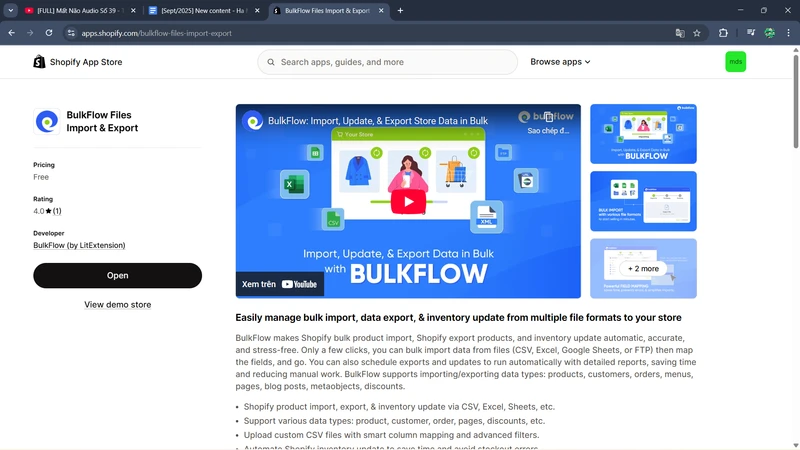
Key Features
- Scheduled imports and exports between Shopify and Google Sheets
- Supports importing products, customers, orders, pages, blog pages, and even complex data like discount codes, variants, metafields, and metaobjects
- Custom field mapping for accurate data alignment
- Scheduled data update to keep sheets and Shopify store always up to date
Pros and Cons
- Pros: Powerful automation, supports complex Shopify data types, helps avoid manual errors, and offers flexible scheduling options
- Cons: Still a new app, limited reviews
Price
- Free
- Pro: $49/month ($470/year)
Install BulkFlow on Shopify: https://apps.shopify.com/bulkflow-files-import-export
#2: Matrixify
Matrixify (formerly Excelify) offers an advanced import/export solution for Shopify, including strong Google Sheets Shopify integration support. It’s designed for efficiently handling large volumes of Shopify data and syncing it with external spreadsheets and databases.
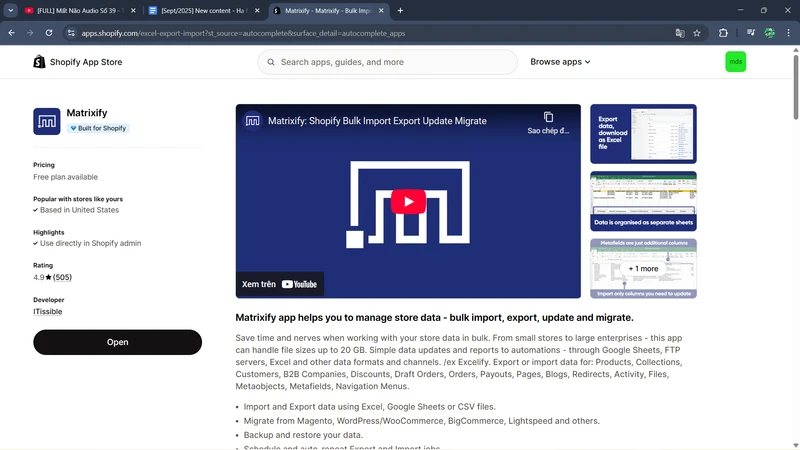
Key Features
- Export and import Shopify data directly to and from Google Sheets
- Supports a wide range of Shopify data types (products, customers, orders, etc.)
- Automation and scheduling capabilities to reduce manual work
- Data validation and error reporting
Pros and Cons
- Pros: Handles very large data sets well, comprehensive Shopify field support, excellent reliability
- Cons: More expensive compared to simpler tools, can be complex for beginners
Price
- Demo: Free
- Basic: $20/month
- Big: $50/month
- Enterprise: $200/month
#3: Sync: Bulk Edit Google Sheets
Sync by StoreSpark offers an intuitive bulk editor that automatically generates a Google Sheet mirroring your entire Shopify product catalog. It allows you to filter, sort, and bulk update product information such as prices, SKUs, and inventory with spreadsheet formulas and real-time syncing.
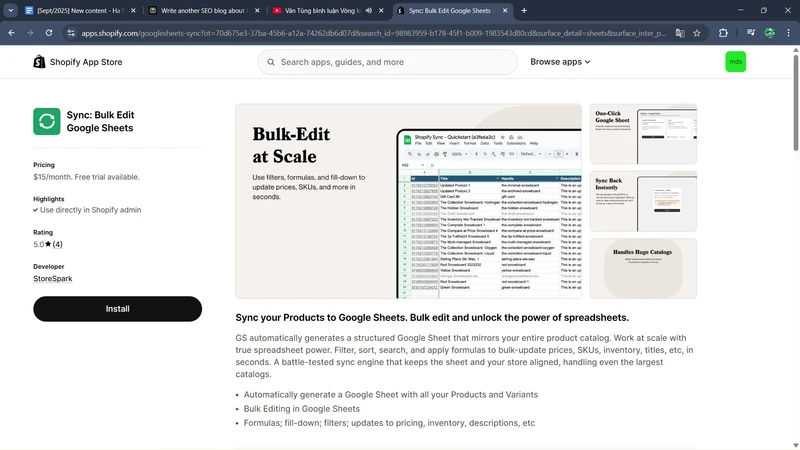
Key Features
- Auto-generated, structured Google Sheet of all products and variants
- Bulk edit prices, inventory, titles, and descriptions with formulas and filters
- Sync changes back to Shopify seamlessly
- Use directly within the Shopify admin dashboard
Pros and Cons
- Pros: Easy to use, prioritizes sync speed and accuracy, tight Shopify admin integration
- Cons: Relatively new app with fewer user reviews. Only support integrating product data.
Price: $15/month with a 7-day free trial.
#4: eCommix ‑ Google Sheets Sync
eCommix provides real-time sync between Shopify and Google Sheets, allowing export and bulk editing of products, orders, customers, and more. It supports custom data like metafields and variant options, and integrates with Google Looker Studio for advanced analytics.
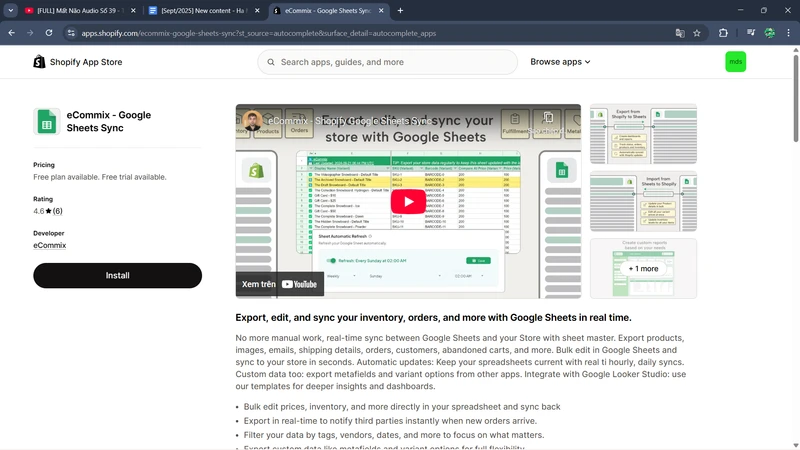
Key Features
- Real-time import from Google Sheets to Shopify and export from Shopify to Google Sheets
- Bulk edit prices, inventory, order data, and customer info
- Supports exports of metafields and custom variant options
- Scheduled hourly or daily syncs for updated spreadsheets
Pros and Cons
- Pros: Real-time updates, broad data type support, flexible filter options
- Cons: Limits in lower tiers on rows imported/exported
Price
- Free
- Starter: $4.99/month
- Professional: $14.99/month
- Enterprise: $29.99/month
Guide to Shopify Google Sheets Integration with BulkFlow
BulkFlow offers a powerful yet user-friendly solution to connect Shopify with Google Sheets, allowing merchants to automate bulk data updates between their store and spreadsheets. Here is the step-by-step guide:
- Step 1: Connect your Shopify store to BulkFlow
- Step 2: Create a new feed
- Step 3: Import your Google Sheet file
- Step 4: Set up scheduling and automation
Step 1: Connect your Shopify store to BulkFlow
The first step is to link your BulkFlow account and Shopify. There are two ways to do it:
- Option 1: Go to Shopify Admin > Apps and install BulkFlow Files Import & Export
- Option 2: Create a BulkFlow account and connect it to your Shopify account.
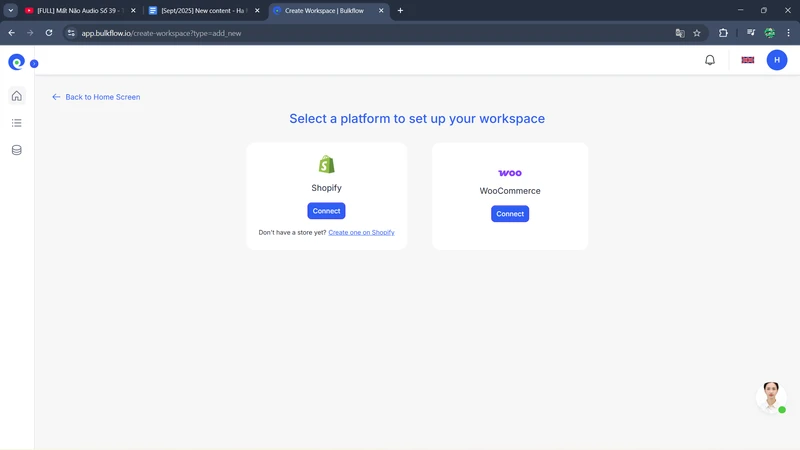
Step 2: Create a new feed
Then, you need to create a new import feed. Within BulkFlow’s dashboard, choose Create New Feed > Add New/Update:
- Use Add New if you want to import new items and update the existing ones on your Shopify store.
- Use Update if you only adjust existing items in your Shopify store.
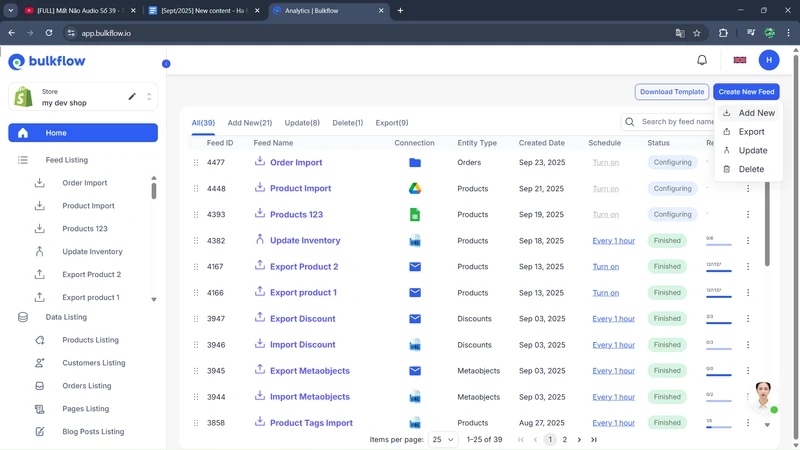
In the feed setup, name your feed, turn on update existing data as you want, and choose the data entry type. With BulkFlow, you can import products, customers, orders, pages, and even complex data types like metaobjects.
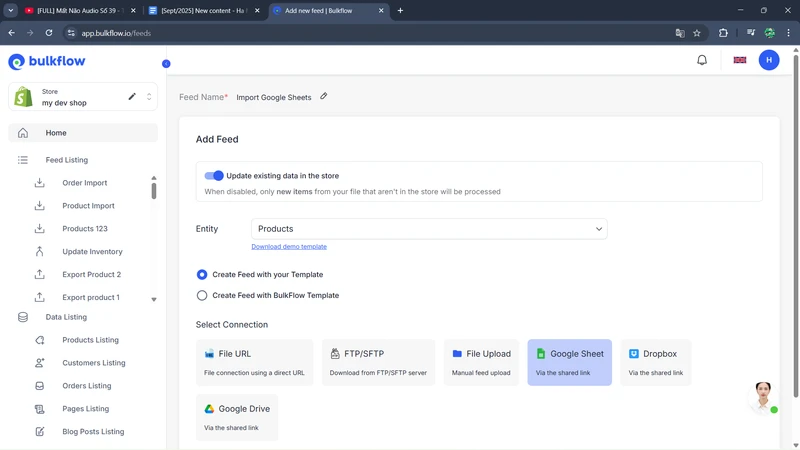
For file format and connection settings, BulkFlow gives you the following options:
- Create a Feed with your Template: Choose it when you already have an existing data file.
- Create Feed with BulkFlow Template: You can use it when you want to start from scratch. Using the BulkFlow template can help you skip the Field mapping step later.
So if you already have a Google Sheets file, choose Create Feed with your Template and Google Sheets connection. When you’re done, click Continue.
Step 3: Import your Google Sheet file
The next step is importing your data to Shopify. You will need to do 2 tasks:
Link your file to BulkFlow
BulkFlow will ask you to connect your file based on your chosen connection methods. For Google Sheets, you just need to paste your file’s link and press Test Connection to see if BulkFlow can access it. Remember to set your file to Public or add BulkFlow’s email to grant permission.
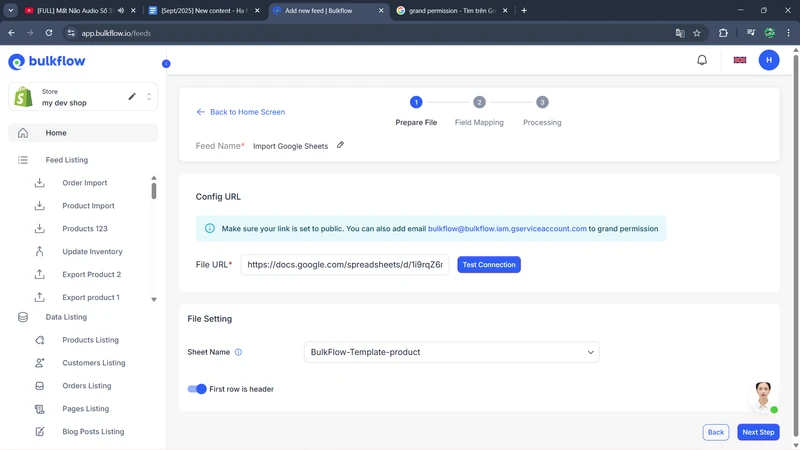
When BulkFlow finishes verifying your Google Sheets, select the sheet name and the header row. Then, click Next Step to proceed to the next task.
Map your file’s columns
A benefit of BulkFlow compared to other third-party solutions is that you can import your own file. This is possible thanks to BulkFlow’s advanced mapping feature.

After uploading your file, BulkFlow attempts to map the headers in your Google Sheets to those in Shopify. For the columns that BulkFlow cannot map, there is still a Generative AI mapping suggestions tool to help you, or you can map them yourself.
When you’re done, click Next step to start the process.
Step 4: Set up scheduling and automation
When the import process is complete, you can check all your uploaded information on BulkFlow’s result page or directly on Shopify admin.
Also, on the result page, you can activate the Automate feed feature. You can set up frequency from hourly to daily. This ensures that all changes made to your Google Sheets file are automatically updated in your Shopify store.
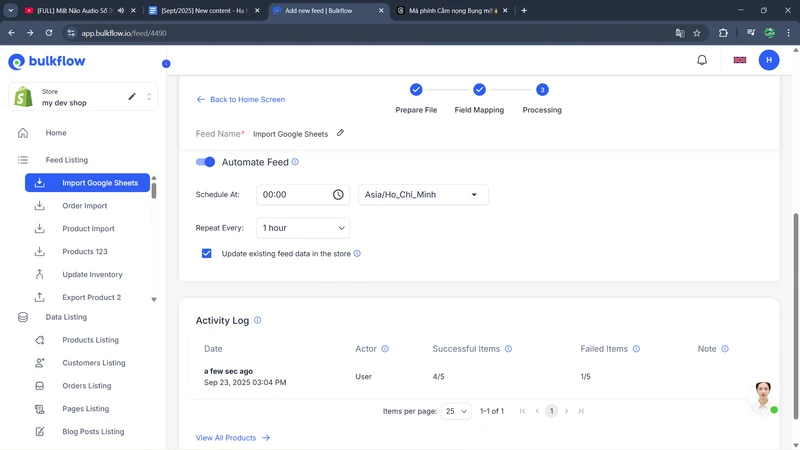
In addition, you can check your import feed status in the Activity log. Here are some details that you should pay attention to:
- Successful items: The number of items that were successfully imported to your Shopify store.
- Failed Items: The number of items that cannot be imported to your Shopify store.
Shopify Google Sheets Integration – FAQs
How to integrate Shopify with Google Sheets?
You can integrate Shopify Google Sheets using apps like BulkFlow, following these steps:
1. Connect your Shopify store to BulkFlow
2. Create a new feed
3. Import your Google Sheet file
4. Set up scheduling and automation
Can I import Shopify orders to Google Sheet?
By default, Shopify does not allow direct importing of orders into Google Sheets. The usual workaround is to export your orders from Shopify into a CSV or Excel file, then manually upload that file into Google Sheets. Alternatively, you can use third-party apps to automate the export process for you.
What methods for Shopify Google Sheets integration?
There are two possible methods for integrating Google Sheets Shopify:
Method 1: Export the Google Sheet file to a CSV file, then import it to your Shopify store.
Method 2: Integrate the Google Sheet file to Shopify via BulkFlow.
Conclusion
Shopify Google Sheets integration empowers store owners with real-time data access, automated workflows, and collaborative tools to grow their business smarter. By connecting Shopify’s rich eCommerce data to Google Sheets’ flexible spreadsheet environment, merchants gain greater control over their store data.
Leveraging trusted integration apps like BulkFlow helps simplify complex data syncing and keeps your Shopify store running smoothly and efficiently from today on.




